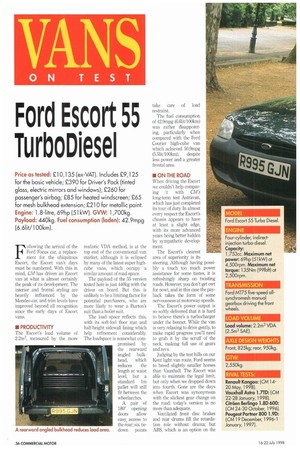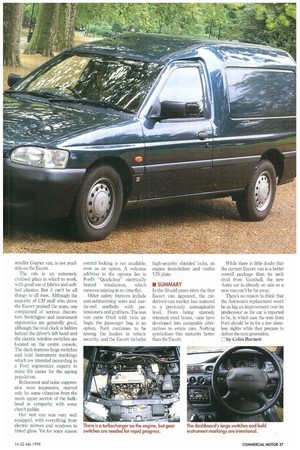VANS
Page 48

Page 49

If you've noticed an error in this article please click here to report it so we can fix it.
ON TEST
Ford Escort 55 TurboDiesel
Price as tested: £10,135 (ex-VAT). Includes £9,125 for the basic vehicle; £390 for Driver's Pack (tinted glass, electric mirrors and windows); £260 for passenger's airbag; £85 for heated windscreen; £65 for mesh bulkhead extension; £210 for metallic paint. Engine: 1.8-litre, 69hp (51kW). MAN: 1,700k9. Payload: 440k9. Fuel consumption (laden): 42.9mpg (6.61it/100km).
Following the arrival of the Ford Focus car, a replace. ment for the ubiquitous Escort, the Escort van's days must be numbered. With this in mind, CM has driven an Escort van at what is almost certainly the peak of its development. The interior and frontal styling are heavily influenced by the Mondeo car, and trim levels have improved beyond all recognition since the early days of Escort vans.
• PRODUCTIVITY The Escort's load volume of 2.2m3, measured by the more
realistic VDA method, is at the top end of the conventional van market, although it is eclipsed by many of the latest super highcube vans, which occupy a similar amount of road space.
The payload of the 55 version tested here is just 440kg with the driver on board. But this is unlikely to be a limiting factor for potential purchasers, who are more likely to wear a Burton's Suit than a boiler suit.
The load space reflects this, with its soft-feel floor mat and half-height sidewall lining which help refinement considerably. The loadspace is somewhat compromised by the rearward angled bulkhead, which reduces the length at waist level, but a standard lm pallet will still fit between the wheelarches.
A pair of 180° opening doors allow easy. access to the rear; six tiedown points
take care of load restraint.
The fuel consumption of 42.9mpg (6.61it/100km) was rather disappointing, particularly when compared with the Ford Courier high-cube van which achieved 50.9mpg (5.51it/100km), despite less power and a greater frontal area.
• ON THE ROAD When driving the Escort we couldn't help comparing it with CM's long-term test Astravan, which has just completed its tour of duty. In almost every respect the Escort's chassis appears to have at least a slight edge, with its more advanced years being better hidden by sympathetic development.
The Escort's clearest area of superiority is its steering Although having possibly a touch too much power assistance for some tastes, it is refreshingly sharp on twisting roads. However, you don't get owt for nowt, and in this case the payback takes the form of some nervousness at motorway speeds.
The Escort's power output is so softly delivered that it is hard to believe there's a turbocharger under the bonnet. While the van is very relaxing to drive gently, to make rapid progress you'll need to grab it by the scruff of the neck, making full use of gears and revs.
Judging by the test hills on our Kent light van route, Ford seems to breed slightly smaller horses than Vauxhall. The Escort was able to maintain the legal limit, but only when we dropped down into fourth. Gone are the days when Escort was synonymous with the slickest gear change on the road: today's version is no more than adequate.
Ventilated front disc brakes and rear drums fill the retardation role without drama; but ABS, which is an option on the smaller Courier van, is not available on the Escort.
The cab is an extremely civilised place in which to work, with good use of fabrics and softfeel plastics. But it can't be all things to all men. Although the majority of CM staff who drove the Escort praised the seats, one complained of serious discomfort. Switchgear and instrument ergonomics are generally good, although the oval clock is hidden behind the driver's left hand and the electric window switches are located on the centre console. The dash features large switches and bold instrument markings which are intended (according to a Ford ergonomics expert) to make life easier for the ageing population.
Refinement and noise suppression were impressive, marred only, by some vibration from the mesh upper section of the bulkhead in sympathy with some clutch judder.
Our test van was very well equipped, with everything from electric mirrors and windows to tinted glass, Yet for some reason central locking is not available, even as an option. A welcome addition to the options list is Ford's "Quickclear" electrically heated windscreen, which removes misting in no time flat.
Other safety features include anti-submarining seats and inertia-reel seatbelts with pretensioners and grabbers. The test van came fitted with twin air bags; the passenger bag is an option. Ford continues to be among the leaders in vehicle security, and the Escort includes high-security shielded locks, an engine immobiliser and visible YIN plate.
II SUMMARY
In the 30-odd years since the first Escort van appeared, the carderived-van market has matured to a previously unimaginable level. From being sparsely trimmed steel boxes, vans have developed into acceptable alternatives to estate cars. Nothing symbolises this maturity better than the Escort, While there is little doubt that the current Escort van is a better overall package than its arch rival from Vauxhall, the new Astra car is already on sale so a new van can't be far away.
There's no reason to think that the Astravan's replacement won't be as big an improvement over its predecessor as the car is reported to be, in which case the men from Ford should be in for a few sleepless nights while they prepare to deliver the next generation.
E by Colin Barnett MODEL
Ford Escort 55 Turbo Diesel.
Four-cylinder, indirectinjection turbo-diesel. Capacity: 1,753cc. Maximum net power: 69hp (51kW) at 4,500rpm. Maximum net torque: 1 35Nm (991E40 at 2,50Orpm.
TRANSMISSION
Ford M175 five-speed allsynchromesh manual gearbox driving the front wheels.
LOAD VOLUME Load volume: 2.2m3 VDA (2.5m3 SAE).
AXLE DESIGN WEIGHTS
Front, 825kg; rear, 950k9.
GTW:
2,550kg.
RIVAL TESTS: Renault Kangoo: (CM 1420 May, 1998).
Vauxhall Astra 1.7TD: (CM 22-28 January, 1998). Citroen Berlingo 1.8D 600: (CM 24-30 October, 1 996). Peugeot Partner 800 1.9D: ( CM 19 December, 1 9961 January, 1997).
















































































































